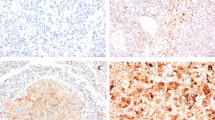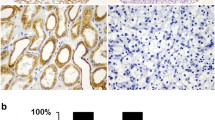Abstract
Vasohibin-1(VASH1) has recently been isolated as a novel negative feedback inhibitor of angiogenesis. Several studies have demonstrated that VASH1 plays important roles in tumor angiogenesis but the role of this angiogenic inhibitor in renal cell carcinoma (RCC) has not been elucidated until now. In this study, we investigated the expression pattern of VASH1 and the association with clinicopathological features in RCC. Expression of VASH1, hypoxia-inducible factor-1α (HIF-1α), and microvessel density (MVD, labeled by CD34) was assessed by immunohistochemistry in 46 RCC specimens and 20 adjacent nontumorous renal tissues (ANRTs). Correlation between vasohibin-1 and HIF-1α, MVD, and clinicopathological features was then investigated. In RCC, VASH1 was expressed mainly in the cytoplasm and membrane of tumor cells and partly in vascular endothelial cells. In ANRT, it was mainly expressed in the cytoplasm and membrane of renal tubular epithelial cells and partly in vascular endothelial cells and glomerular mesangial cells. The expression level of VASH1 in RCC tissue was significantly lower than that in ANRT and was significantly reduced with the increased degree of malignancy in RCC tissues. In addition, a significantly negative correlation was noted between VASH1 expression and HIF-1α expression and a significantly negative correlation was noted between VASH1 expression and MVD in RCC. Therefore, VASH1 expression is reduced and it associates with clinicopathological features in RCC. Based on our findings and the knowledge of other angiogenesis inhibitors, we postulate that VASH1 would potentially be a biomarker and a candidate for molecular targeted therapy for patients with RCC in the future.





Similar content being viewed by others
References
Rini BI, Campbell SC, Escudier B. Renal cell carcinoma. Lancet. 2009;373:1119–32.
Motzer RJ, Bander NH, Nanus DM. Renal-cell carcinoma. N Engl J Med. 1996;335:865–75.
Ljungberg B, Campbell SC, Cho HY, Jacqmin D, Lee JE, Weikert S, et al. The epidemiology of renal cell carcinoma. Eur Urol Eur Urol. 2011;60(4):615–21.
Folkman J. Tumor angiogenesis: therapeutic implications. N Engl J Med. 1971;285:1182–6.
Folkman J, Kerbel R. Role of angiogenesis in tumor growth and metastasis Clinical translation of angiogenesis inhibitors. Semin Oncol. 2002;29:15–8.
Carmeliet P, Jain RK. Angiogenesis in cancer and other diseases. Nature. 2000;407:249–57.
Qian CN, Huang D, Wondergem B, Teh BT. Complexity of tumor vasculature in clear cell renal cell carcinoma. Cancer. 2009;115:2282–9.
Xu L, Tong R, Cochran DM, Jain RK. Blocking platelet-derived growth factor-D/platelet-derived growth factor receptor beta signaling inhibits human renal cell carcinoma progression in an orthotopic mouse model. Cancer Res. 2005;65:5711–9.
Sulzbacher I, Birner P, Traxler M, Marberger M, Haitel A. Expression of platelet-derived growth factor-alpha alpha receptor is associated with tumor progression in clear cell renal cell carcinoma. Am J Clin Pathol. 2003;120:107–12.
Dorević G, Matusan-Ilijas K, Babarović E, et al. Hypoxia inducible factor-1α correlates with vascular endothelial growth factor A and C indicating worse prognosis in clear cell renal cell carcinoma. J Exp Clin Cancer Res. 2009;28:40.
Watanabe K, Hasegawa Y, Yamashita H, et al. Vasohibin as an endothelium-derived negative feedback regulator of angiogenesis. J Clin Invest. 2004;114:898–907.
Sonoda H, Ohta H, Watanabe K, et al. Multiple processing forms and their biological activities of a novel angiogenesis inhibitor vasohibin. Biochem Biophys Res Commun. 2006;342:640–6.
Nasu T, Maeshima Y, Kinomura M, et al. Vasohibin-1, a negative feedback regulator of angiogenesis, ameliorates renal alterations in a mouse model of diabetic nephropathy. Diabetes. 2009;58:2365–75.
Shen J, Yang X, Xiao WH, et al. Vasohibin is up-regulated by VEGF in the retina and suppresses VEGF receptor 2 and retinal neovascularization. FASEB J. 2006;20:723–5.
Tamaki K, Moriya T, Sato Y, et al. Vasohibin-1 in human breast carcinoma: a potential negative feedback regulator of angiogenesis. Cancer Sci. 2009;100:88–94.
Yoshinaga K, Ito K, Moriya T, et al. Expression of vasohibin as a novel endothelium-derived angiogenesis inhibitor in endometrial cancer. Cancer Sci. 2008;99:914–9.
Yoshinaga K, Ito K, Moriya T, et al. Roles of intrinsic angiogenesis inhibitor, vasohibin, in cervical carcinomas. Cancer Sci. 2011;102:446–51.
Hosaka T, Kimura H, Heishi T, et al. Vasohibin-1 expression in endothelium of tumor blood vessels regulates angiogenesis. Am J Pathol. 2009;175:430–9.
Wang Q, Tian X, Zhang C, et al. Upregulation of vasohibin-1 expression with angiogenesis and poor prognosis of hepatocellular carcinoma after curative surgery. Med Oncol. 2011. doi:10.1007/s12032-011-0106-7.
Shen Z, Kauttu T, Seppänen H, et al. Vasohibin-1 and vasohibin-2 expression in gastric cancer cells and TAMs. Med Oncol. 2012;. doi:10.1007/s12032-012-0212-1.
Eble JN, Sauter G, Epstein JI, et al. Pathology and genetics of tumours of the urinary system and male genital organs. Lyon: IARC; 2004. p. 12–43.
Störkel S, Eble JN, Adlakha K, et al. Classification of renal cell carcinoma. Cancer. 1997;80:987–9.
Edge SB, Byrd DR, Compton CC, et al. AJCC cancer staging manual. 7th ed. New York: Springer; 2009. p. 547–60.
Mancilla JR, Stanley RJ, Blath RA. Papillary renal cell carcinoma: a clinical, radiologic, and pathologic study of 34 cases. Cancer. 1976;38:2469–80.
Shimizu K, Watanabe K, Yamashita H, et al. Gene regulation of a novel angiogenesis inhibitor, vasohibin, in endothelial cells. Biochem Biophys Res Commun. 2005;327:700–6.
Nimmagadda S, Geetha-Loganathan P, Pröls F, et al. Expression pattern of vasohibin during chick development. Dev Dyn. 2007;236:1358–62.
Naito H, Kidoya H, Sato Y, et al. Induction and expression of anti-angiogenic vasohibins in the hematopoietic stem/progenitor cell population. J Biochem. 2009;145:653–9.
Vaupel P, Mayer A. Hypoxia in cancer: significance and impact on clinical outcome. Cancer Metastasis Rev. 2007;26:225–39.
Pantuck AJ, Zeng G, Belldegrun AS, et al. Pathobiology, prognosis and targeted therapy for renal cell carcinoma: exploiting the hypoxia-induced pathway. Clin Cancer Res. 2003;9:4641–52.
Marcella M. van Vlodrop IJH, Vermeulen PB, et al. VHL and HIF signalling in renal cell carcinogenesis. J Pathol. 2010;221:125–38.
Ferrara N. Role of vascular endothelial growth factor in the regulation of angiogenesis. Kidney Int. 1999;56:794–814.
Jacobsen J, Grankvist K, Rasmuson T, et al. Expression of vascular endothelial growth factor protein in human renal cell carcinoma. BJU Int. 2004;93(3):297–302.
Lidgren A, Hedberg Y, Grankvist K. ea al. Hypoxia-inducible factor 1a expression in renal cell carcinoma analyzed by tissue microarray. Eur Urol. 2006;50:1272–7.
Lidgren A, Hedberg Y, Grankvist K, et al. The expression of hypoxia-inducible factor 1alpha is a favorable independent prognostic factor in renal cell carcinoma. Clin Cancer Res. 2005;11:1129–35.
Weidner N. Current pathologic methods for measuring intratumoral microvessel density within breast carcinoma and other solid tumors. Breast Cancer Res Treat. 1995;36:169–80.
Delahunt B, Bethwaite PB, Thornton A. Prognostic significance of microscopic vascularity for clear cell renal cell carcinoma. Br J Urol. 1997;80:401–4.
Yildiz E, Ayan S, Goze F, et al. Relation of microvessel density with microvascular invasion, metastasis and prognosis in renal cell carcinoma. BJU Int. 2008;101(6):758–64.
Dekel Y, Koren R, Kugel V, et al. Significance of angiogenesis and microvascular invasion in renal cell carcinoma. Pathol Oncol Res. 2002;8:129–32.
Joo HJ, Oh DK, Kim YS, et al. Increased expression of caveolin-1 and microvessel density correlates with metastasis and poor prognosis in clear cell renal cell carcinoma. BJU Int. 2004;93(3):291–6.
Suzuki K, Morita T, Hashimoto S, Tokue A. Thymidine phosphorylase/platelet-derived cell growth factor (PD-ECGF) associated with prognosis in renal cell carcinoma. Urol Res. 2001;29:7–12.
Slaton JW, Inoue K, Perrotte P, et al. Expression levels of genes that regulate metastasis and angiogenesis correlate with advanced pathological stage of renal cell carcinoma. Am J Pathol. 2001;158:735–43.
Miyashita H, Suzuki H, Ohkuchi A, et al. Mutual balance between vasohibin-1 and soluble VEGFR-1 in endothelial cells. Pharmaceuticals. 2011;4:782–93.
Wakusawa R, Abe T, Sato H, et al. Suppression of choroidal neovascularization by vasohibin-1, a vascular endothelium–derived angiogenic inhibitor. Invest Ophthalmol Vis Sci. 2011;52:3272–80.
Kozako T, Matsumoto N, Kuramoto Y, et al. Vasohibin induces prolyl hydroxylase-mediated degradation of hypoxia-inducible factor-1a in human umbilical vein endothelial cells. FEBS Lett. 2012;586:1067–72.
Conflict of interests
The authors declare that they have no conflict of interest.
Author information
Authors and Affiliations
Corresponding authors
Rights and permissions
About this article
Cite this article
Zhao, G., Yang, Y., Tang, Y. et al. Reduced expression of vasohibin-1 is associated with clinicopathological features in renal cell carcinoma. Med Oncol 29, 3325–3334 (2012). https://doi.org/10.1007/s12032-012-0313-x
Received:
Accepted:
Published:
Issue Date:
DOI: https://doi.org/10.1007/s12032-012-0313-x




